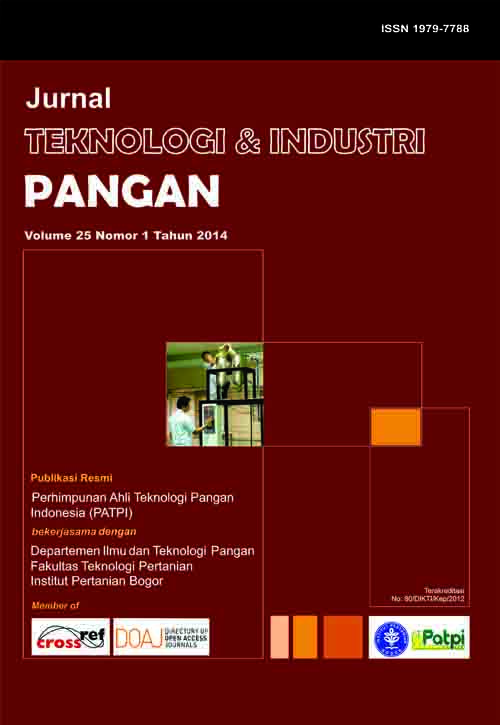OPTIMASI NANOENKAPSULASI ASAP CAIR TEMPURUNG KELAPA DENGAN RESPONSE SURFACE METHODOLOGY DAN KARAKTERISASI NANOKAPSUL [Optimization of Coconut Shell Liquid Smoke Nanoencapsulation using Response Surface Methodology and Nanocapsules Characterization]
Abstract
OPTIMASI NANOENKAPSULASI ASAP CAIR TEMPURUNG KELAPA DENGAN RESPONSE SURFACE METHODOLOGY DAN KARAKTERISASI NANOKAPSUL
[Optimization of Coconut Shell Liquid Smoke Nanoencapsulation
using Response Surface Methodology and Nanocapsules Characterization]
Dego Yusa Ali1), Purnama Darmadji2)* dan Yudi Pranoto2)
1) Jurusan Teknologi Industri Pertanian, Fakultas Teknologi Pertanian, Universitas Jambi, Jambi
2) Jurusan Teknologi Pangan dan Hasil Pertanian, Fakultas Teknologi Pertanian, Universitas Gadjah Mada, Yogyakarta
Diterima 15 November 2013 / Disetujui 07 Februari 2014
ABSTRACT
Liquid smoke is impractical and easy to deteriorate, thus needs to be protected against deterioration. Spray drying technique is widely used to encapsule bioactive compounds. This study aims to determine the optimum encapsulant ratio and spray drying process to produce nanocapsule of liqud smoke. Nanocapsules production began with the mixing of encapsulant (chitosan and maltodextrin) and the liquid smoke and then agitated until dissolved. The solution of nanoparticles was heated in a water bath at 45°C for 5 minutes and homogenized using a homogenizer at 4000 rpm for 1 min. The nanoparticle solutions was spray dried at various temperatures and feed flow rates. Optimization is accomplished by using Response Surface Methodology (RSM), and the parameters to be optimized were chitosan concentration, inlet air temperature and feed flow rate of the spray dryer based on total phenolic content. Samples were analyzed for viscosity, pH, phenols staining, total phenolic, total carbonil, total acidity content, encapsulation efficiency, morphology profiles, and particle size distribution. The results showed that the nanoparticles solution of liquid smoke had a pH ranged between 2.55-2.64 total soluble solids ranged between 14-14.8°Brix and viscosity ranged between 8.7-14.9 centipoise (cP). The total phenolic content of the nanocapsules ranged from 1.38 to 2.32% with an efficiency ranged from 22.25 to 37.44%, and water content ranged from 9.56 to 10.73% (dry basis). The optimum conditions for the highest value of total phenolic content were 0.12% chitosan concentration, 140.65°C inlet air temperature and feed flow rate at 5.29 mL/min. The results suggested that nanocapsules had spherical and wrinkle shape with an average size of nanocapsules of 29.16 nm.

